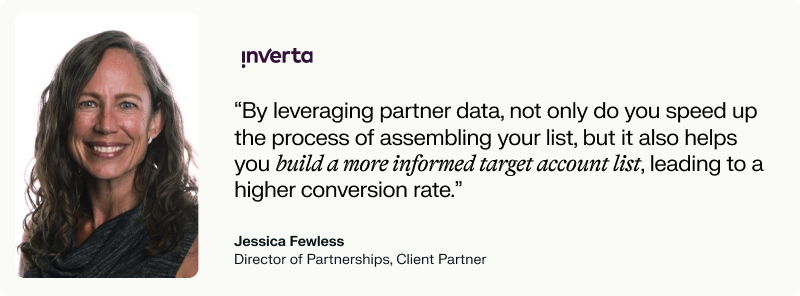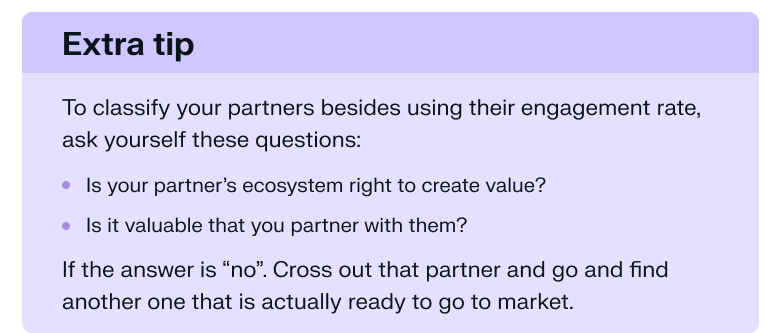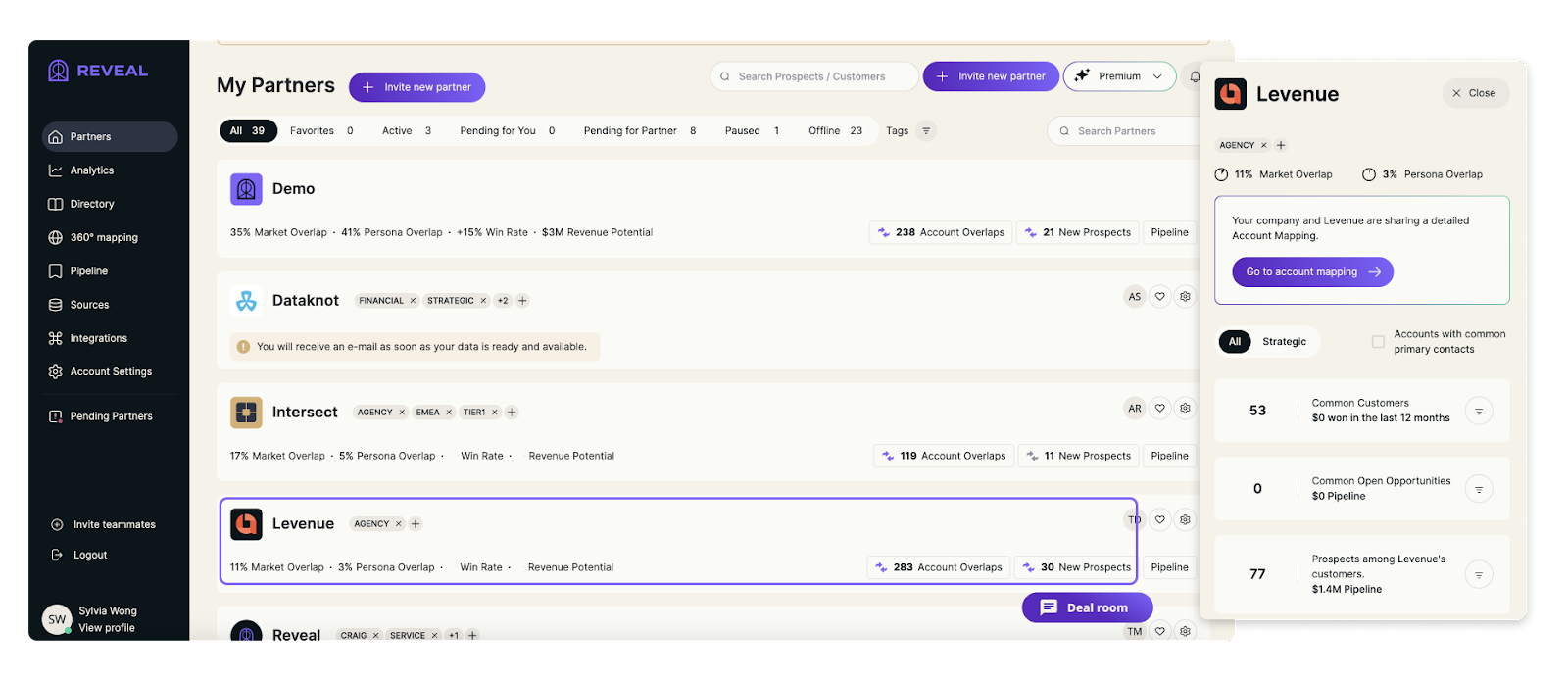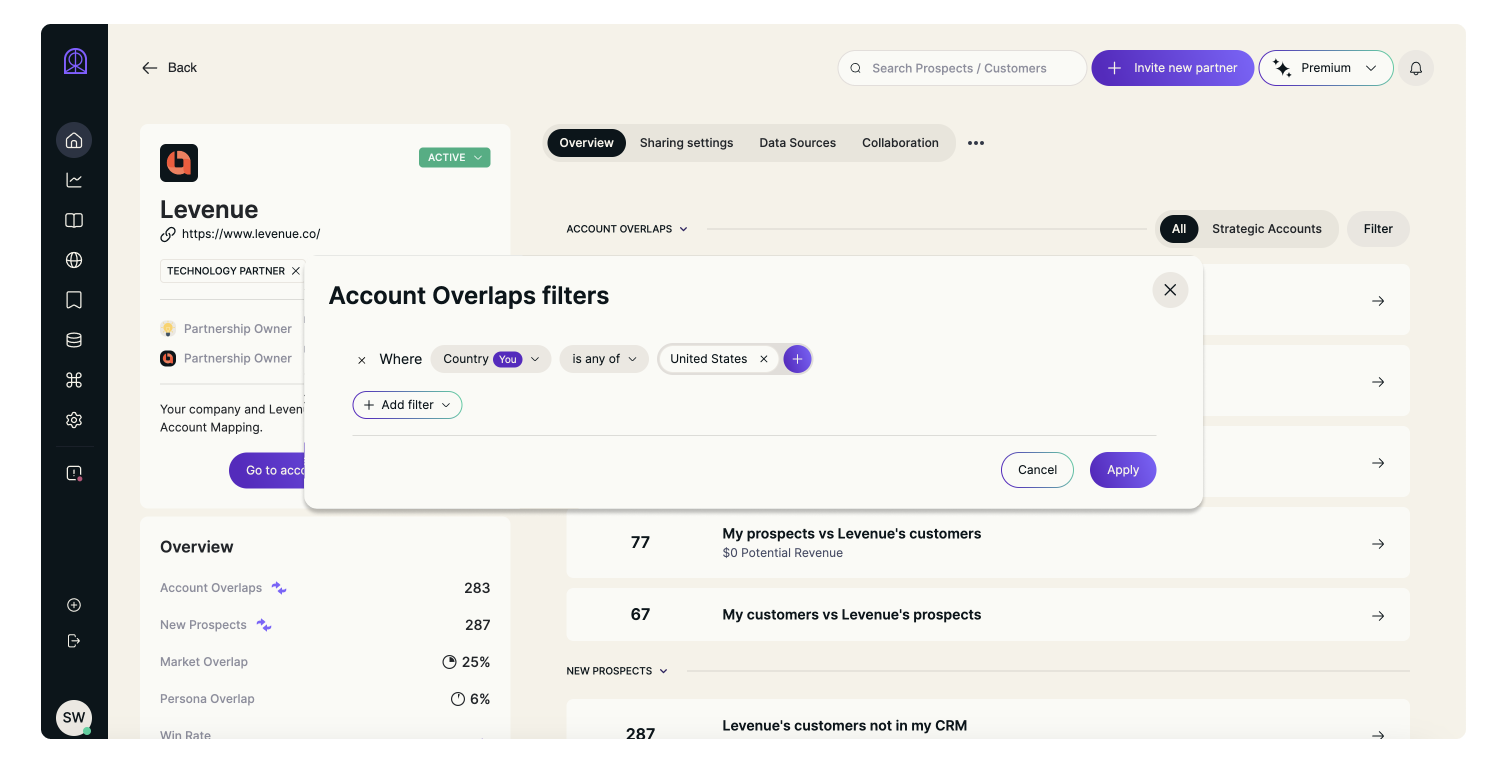In this blog you’ll learn:
-
What is a Nearbound ABM Marketing strategy?
-
How to implement a Nearbound ABM Marketing strategy.
-
How to get buy-in to implement a Nearbound ABM strategy
The effectiveness of outbound and inbound strategies is stalling.
Buyers don’t want to see another random name come through their inbox or see another ad in their daily deluge of 10,000 impressions (Deloitte).
This has made it difficult for companies to grab buyers’ attention.
Marketers must work to target prospects with valuable content that addresses their work challenges. It’s not about sending generic cold emails; it’s about providing tailored value that scales.
It’s also about aligning that messaging alongside the service providers the prospect already trusts.
In 2022, 62% of consumers emphasized the importance of personalized messages for brand loyalty, a significant increase from 45% the previous year.
Building trust means delivering the right message at the right time to each individual. Understanding what each account needs is key.
That’s where Nearbound Account-based Marketing (ABM) comes in, revolutionizing how you engage with target accounts.
So, how can you build a Nearbound ABM Marketing strategy?
We sat down with Jessica Fewless, Director of Partnerships and Client Partner at Inverta, to:
-
Understand the structure of a Nearbound ABM strategy
-
Break down how to implement a Nearbound ABM strategy
-
Identify some key use cases
Let’s jump into it.
WTF is a nearbound ABM strategy?
ABM stands for "Account-Based Marketing." It is a strategic approach to marketing that focuses on targeting specific high-value accounts or companies rather than casting a wide net to attract a broad audience. ABM aims to align marketing and sales efforts to effectively engage and nurture individual target accounts.
So, with this in mind, what is Nearbound ABM?
It’s a strategy that has a collective approach that combines the
power of your ecosystem, trusted partnerships, and targeted marketing to accelerate revenue growth and overcome challenges in partnerships, marketing, and sales.
It’s focused on leveraging existing relationships to deliver the right message to the right audience at the right time to give and get the highest value from those targeted accounts.
Some benefits of Nearbound ABM include:
-
Creating a shorter sales cycle since isolated prospects are nurtured simultaneously
-
Helping you achieve higher ROI, according to 85% of marketers
-
Spending fewer resources to close highly qualified accounts.

The basic steps for a nearbound ABM strategy
Besides your usual steps to implement your ABM campaign, you’re going to add only one more step to nail the content and identify those key partnerships, that can help you reach that untapped audience.
Step one: Partners readiness check
You first need to assess the strength of your partner portfolio. And according to Jessica, here are the main types of partners you should focus on:
-
The number of partners that are engaged
-
The number of partners that need reengagement and management (because they are strategic), and
-
The number of partners that are ready to invest resources like time, effort and/or financial resources
By identifying the right partners, you not only deliver valuable content through your Nearbound Account-Based Marketing (ABM) campaign but also create an environment of trust around your prospects. They are not only interested in knowing ’how’ to achieve their goals but also in identifying ’who’ can best assist them in attaining better results.
To effectively navigate the ’Who Economy,’ it is crucial to identify the relevant individuals and their current stage in the partnership journey. Consider creating a partner marketing maturity model or a comprehensive checklist to assess your partners.
It is like doing partner inventory to identify which partner is worth doing a co-marketing motion, and what they need to succeed.
Here’s an easy play to make this happen:
Classify your partners according to their engagement rate. It will be like creating a gamification strategy. This will help your partners to move up on the established categories, making them more proactive and effective.
And if you’re partnering with companies that are competitors between each other, this gamification strategy might help you to keep neutral, since you’re assessing companies based on their level of engagement or readiness to partner.

Step two: Evaluate the existing assets
If you don’t like to receive ads, invites, or emails that don’t bring any value, why will your prospects like it?
Before even starting approaching partners, you should ask yourself:
Is the content valuable? Is it different? Why would people care about it?
Once you have a clear idea of what your customer values the most, you can start thinking about who can help you deliver that value. Consider the following scenarios:
-
Scenario 1: Do you wanna reach out to partners you have already co-market with or made a previous ABM strategy with?
-
Scenario 2: Are you looking to reach out to a new partner with whom you haven’t engaged in an ABM motion before?
Step 3: Identify your partners
At this stage, you have two options: either you ask your Partner Manager for a list of partners that can support your campaign, or you can do it yourself by following these four steps:
1. Identify which partner has the highest market and persona overlap.

2. In Reveal, use “Filters” in the overview to only focus on your specific target ICP.

3. Compare the numbers between your partners and make a prioritized list.
4. You can also leverage Partner Signals in 360° Goals to identify which combination of partners can help you the best with prospects and customers. Once you have identified those key partners, you can start leveraging the trust they have built in that market, and start a co-marketing motion with them.

PRO TIP:
Understand which of your personas benefit or perform better by having both of your solutions together. Get the help of your Partner Manager (from both your team and your partner’s teams), to synthesize both value propositions and create a tailored message for your audience.
Step four: Set clear expectations
Make sure you set clear expectations, not only for your Marketing team but also for the Sales and Partnerships teams on both sides.
When you are strategizing a Nearbound ABM campaign, always keep in mind this question:
What is expected from my teams and my partner teams to contribute to make the whole campaign a success?
To answer that question, make a timeline with all the steps or stages that your campaign will include, define who owns what, and what you expect from each other.
For example, you might not need partner involvement in stages one and two, which are story development, and branding.

Step five: List management
At this next stage, we’re integrating three steps in one, because at the end everything is related to list management:
-
Identifying your high-value target accounts
-
Conduct research on those accounts
-
Develop a customized marketing campaign
To identify your key accounts you have to pull out Reveal’s data, as well as your suppression list from your Sales team. What you might find are all the accounts where you and your Sales team don’t have an overlap–the perfect candidates for your campaign.
And here’s where Nearbound ABM comes in.
Data in Reveal is your Partner Manager’s wish list—every team has one. Just remember that everyone is trying to accomplish their own goals, so you need to find those accounts that are not already on any of your team’s “wish lists”. Create new lists from those account results, and find where you can bring value to those accounts.
This makes the research process a lot easier because your Partner Manager can help you to get intel from your partners, and can meet with your Sales team to compare lists and come up with a plan to best target those accounts.
To develop a customized campaign, you need to identify which of your accounts in the list are ready for an introduction today. Then, with intel provided by your partners, you can create an even more targeted list as you group all the co-selling opportunities and identify those co-marketing opportunities. Like this, you will have a tailored message for each one of your personas.
Develop a better-together story for that persona or vertical you want to target and identify who’s going to make the first step.
For example, if your partner’s solution is for Product teams, and yours is for Marketing teams, what would the value proposition be? Identify who will tell which side of the story.
By doing this, everybody wins. You’re launching a strong Nearbound ABM campaign and your Sales team is going to get their meeting quicker.
Set a 60-day period for your co-selling and co-marketing initiatives since most of the reporting and funding for partnerships is done quarterly. So, to get from where you are to where you want to be, you need to be profitable inside of the existing time framework. So you will have a 30-day “common period” for when people miss meetings, go on vacations, etc.
PRO TIP:
Once you’ve identified your list of target ABM accounts:
-
In Reveal settings, put your ABM list as strategic accounts
-
Go in 360° Goals: your strategic accounts will appear at the top of your list
-
Identify who among your partners can help you work with these top accounts
-
You can also take a look at the Product Signals and the Multipliers. It will help you prioritize the accounts and the partners you should work with for your ABM campaigns
-
You can also use the tags in 360° Goals to look for only a certain type of partners in each of these accounts. Ex: “Marketing Agencies”, “Web eCommerce Agency”, or “Customer Data Platform”.
Step six: The feedback loop
After launching your Nearbound ABM campaign, besides measuring conversion rate, sales velocity, churn rate, and customer acquisition cost, you should also focus on getting and giving feedback.
Here’s what you can do:
-
Have regular checkups with your partners. Assess what is working and how can you help your team achieve better results.
-
Understand and align your goals with your team.
Getting buy-in
Here comes the tricky part, because you are not only getting buy-in for your ABM campaign but also for a partner campaign, you need to justify the involvement of both. This summarizes in one key step of the Nearbound ABM process:
Your suppression list.
Make sure that nobody is marketing to these accounts at the same time as you are. Leverage historical data to know when your last touch point was with those accounts in that list.
In this way, you can select certain accounts/prospects in a list to launch your Nearbound ABM campaign because you know they have already been exposed to brand awareness and visited your website. They have started through the funnel.
For example, you have 100 people in your ABM list who have visited one of your website pages and liked content related to that page. What you can do next is push that type of information through inbound and do the math of how many people booked a meeting or signed up after you launched that campaign.
If you’re getting a bit of resistance from your partner’s side, here’s what you can do:
-
Ask them where are they getting stuck
-
Explain how your campaign will help
-
Build a business case and include them in the math.
-
State your priorities and get that foundation done.
Use cases
Nearbound ABM is not only effective for Marketing teams, but also for Partnership teams, here are a couple of extra milestones you can achieve with it:
Monetizing enterprises’ ecosystem
Involving partners in a targeted list can help you pull in more intel around your customer’s workflows, letting you tell a better-together story and provide higher value.
It is more likely that you get support for your campaign if you involve the right people at the right moment.
Once you start your Nearbound ABM campaign, make sure you align with all your partners on where and how you can drive demand gen. To make this happen combine your partner and your company-wide efforts, interactions, relationship-building efforts, and integrate digital marketing strategies.
Demonstrate that partnerships can be profitable
Picture this: you’re building a new partnership program you have limited access to intel and you don’t know how to build that business case.
We know it might be hard, but this is what your business case should include:
-
The annual dollar value of the overlapping accounts
-
What’s your distance from that relationship? (Is it customer-to-customer, prospect vs customer, etc.?)
-
Build that information into a list, de-risking it, and show your C-Suite what the revenue value is
From an ABM perspective, you can get two buckets: expansion revenue and net new revenue. And both of them can be leveraged through partners.
However, partners have more influence on the expansion revenue than on the net new one. Because when you surround the purchase process with the trust that already exists in your ecosystem–a.k.a. leveraging Nearbound–buyers trust more on your solution. As a result, customers are more inclined to renew their contracts, make upgrades, or make additional purchases.
It’s important to note that while partners contribute intel to reduce churn and increase net new revenue, their impact is not as significant as that of acquiring new customers or securing upgrades.
Sponsoring a partner event
Let’s say that you and your partner hosted an in-person event or a webinar. Now, you have a list of attendees and registrants. So, to leverage Nearbound ABM what you will do is:
-
Identify who from that list are customers of your partner which are your prospects, or vice versa.
-
In case you’re sending the email to your partner’s customers (who are your prospects), send a specific email related to the topic of the event (giving value), and mention your partnership.
-
Show them other companies that have joined your network, and state a clear CTA—which can be booking a demo, visiting your website, etc.
Delivering value and building trust
In a world where personalization and delivering value are increasingly critical for success, a Nearbound ABM strategy empowers businesses to create meaningful connections, drive revenue growth, and establish themselves as trusted partners in their respective industries.
By leveraging the collective power of your ecosystems, trusted partnerships, and targeted marketing, companies can thrive in a competitive landscape and unlock their true potential.
Implementing a Nearbound ABM strategy can be a game-changer for businesses looking to stand out in a world saturated with interruptions.
Ready to supercharge your marketing efforts with a Nearbound ABM campaign? Sign up now and unlock the full potential of targeted, personalized marketing that drives revenue growth.



